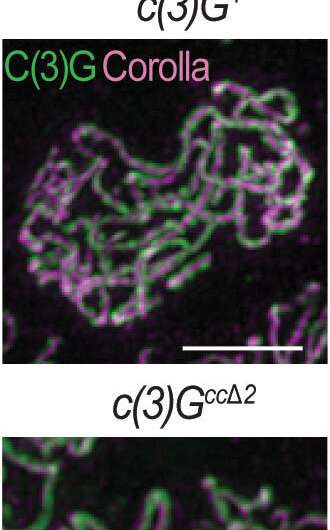X marks the spot: recombination in structurally distinct chromosomes

Two years ago, scientists from the Stowers Institute for Medical Research reported the 3-D structure of the synaptonemal complex in the fruit fly Drosophila melanogaster. This large protein complex is a critical player in the segregation of chromosomes during meiosis, a process of cell division that gives rise to reproductive cells. The synaptonemal complex functions in humans and sexually reproducing animals toward achieving normal, healthy pregnancies.
A recent study from the laboratory of Stowers Investigator Scott Hawley, Ph.D., has revealed more details about how the synaptonemal complex performs its job, including some surprising subtleties in function.
"In humans, there are different mechanisms that can result in aneuploidy, where there's an abnormal number of chromosomes," says Katherine Billmyre, Ph.D., a postdoctoral research associate in the Hawley Lab. "Maternal age is the factor most associated with aneuploidies causing miscarriages, but the second most associated factor is chromosomal recombination defects."
Aneuploidies occur in 10%-50% of human pregnancies. A lack of chromosome crossovers during recombination, during which the DNA strands of homologous chromosome arms break and reform, can result in chromosome mis-segregation.
In the current study, published online September 30, 2019, in the Proceedings of the National Academy of Sciences, co-first author Billmyre and colleagues characterized the role of the fruit fly transverse filament protein C(3)G, a protein in the central region of the synaptonemal complex, in the process of meiotic recombination. By studying mutants in C(3)G that retained some degree of function, they showed that some chromosome arms and regions are more dependent on normal synaptonemal complex than are others.
"The synaptonemal complex is kind of like the teeth of a zipper, and it holds a pair of chromosomes together during meiosis," explains Hawley. "Genes that perform this function in various organisms have been really hard to study, because when you obtain mutations in them, they usually make the gene or protein completely non-functional."
"From a lab point of view, we first became aware about 16 or 17 years ago that synaptonemal complex components were worth careful study," says Hawley. "This is one of the first times we've had a partial loss-of-function version of one of these genes and have been able to study how it works in more detail. It's been amazing to have this tool after so many years."
"We suspected that changing the length of the predicted coiled coil region of the C(3)G protein would cause problems," says Billmyre. The team made several fruit fly strains, each having a different disruption in the C(3)G coiled coil, using a very precise gene-editing approach.
Using the CRISPR/Cas9 system, co-first author Cori Cahoon, Ph.D., who performed her predoctoral research in the Hawley Lab, engineered three fruit fly strains carrying precise deletions designed to disrupt the coiled coil domain. The largest deletion removed a 213 amino acid sequence, and the others removed a 16 amino acid sequence and a 7 amino acid sequence within the target region of the larger deletion. When the mutant phenotypes were characterized, the findings were not at all what the researchers expected.
"The rules were, until Katie and Cori's analyses, that anything that affected how chromosomes interacted was true for all chromosomes," says Hawley.
Billmyre and Cahoon found that the deletions affected the X chromosome differently than autosomes (non-sex chromosomes). For instance, both the 213 amino acid and 7 amino acid deletion, but not the 16 amino acid deletion, exhibited significantly reduced rates of recombination on the X chromosome.
Moreover, the three deletion mutants exhibited synaptonemal complex defects that initiated at different times. Premature loss of the intact synaptonemal complex occurred at different stages of meiosis for each mutant. Of note, although the 7 amino acid deletion mutant harbored the smallest sequence deletion, the researchers found that an intact synaptonemal complex never formed.
Taken together, these results highlight that "for some proteins, their structure may be more important than their primary amino acid sequence," says Hawley.
"We didn't expect to see these different phenotypes on different chromosomes. We would have predicted that if you have something wrong with the synaptonemal complex, that you'd see a similar effect everywhere," says Billmyre. But, she says, "there are clearly differences in how the X chromosome and the autosome are reacting to their environments."
Whether it is the identity of chromosomes (sex versus autosome), or their structure that causes differential interactions with the synaptonemal complex remains to be elucidated.
"I do think that the chromosome-specific aspect of the phenotype is very applicable to human meiotic defects," says Billmyre.
The Hawley Lab plans on expanding this research using a structural biology approach and markers to determine whether the location of synaptonemal complex is where crossovers occur, how proteins within the synaptonemal complex interact, and how such small deletions can cause the synaptonemal complex to be unstable.
Billmyre has a background in developmental and cell biology, and she plans to build off this work to better understand why some regions of the genome are more sensitive than others to recombination defects, and how crossover location informs chromosome segregation.
More information: Katherine Kretovich Billmyre et al, X chromosome and autosomal recombination are differentially sensitive to disruptions in SC maintenance, Proceedings of the National Academy of Sciences (2019). DOI: 10.1073/pnas.1910840116
Journal information: Proceedings of the National Academy of Sciences
Provided by Stowers Institute for Medical Research





















